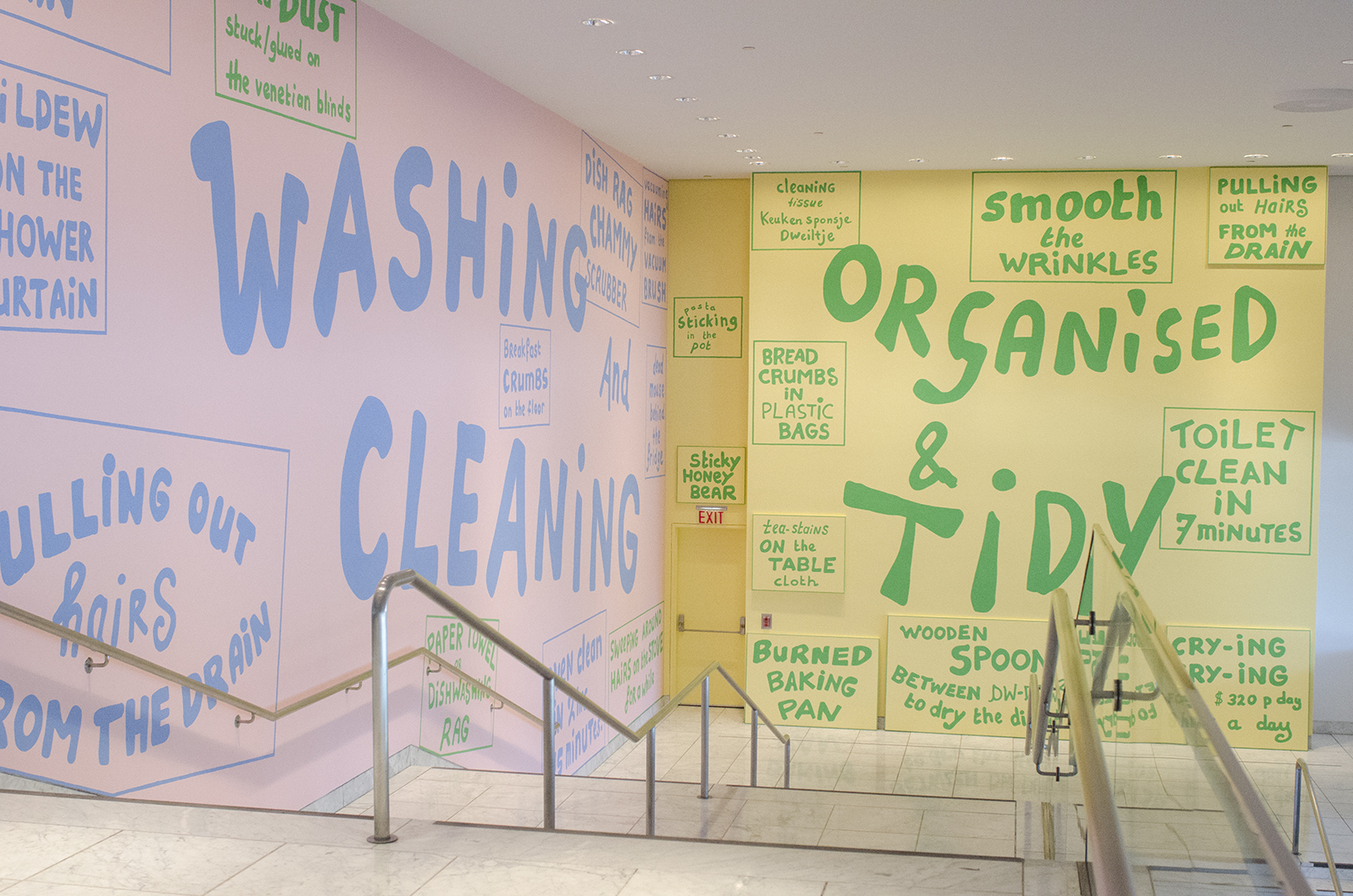Q&A: Hammer Museum curator talks Lily van der Stokker’s feminist art

Dutch contemporary artist Lily van der Stokker is currently displaying her multi-dimensional art installations on the Hammer Museum’s walls.
(Monica Jeon/Daily Bruin)
By Gail Acosta
April 16, 2015 2:26 a.m.
As they enter the Hammer Museum, museumgoers are greeted by bold letters on a yellow and pink wall.
It was here in the museum lobby where Dutch contemporary artist Lily van der Stokker left her large-scale wall paintings, following the likes of artists such as Barbara Kruger. Throughout March, van der Stokker spent a period of 10 days creating her multi-dimensional installations in which she attempted to question gender roles and women’s roles in domestic settings. Prior to creating her artwork at the Hammer, she painted other colorful, large-scale artworks including “Blue Blob Drop Wallpainting” and “Extremely Experimental Art by Older People.”
The exhibit, coordinated by senior curator Anne Ellegood and curator assistant Mackenzie Stevens, is on display at the Hammer Museum through June 3.
The Daily Bruin’s Gail Acosta spoke with Stevens about curating the exhibit, the process of installing van der Stokker’s artwork and the exhibitions’ themes.
Daily Bruin: How did the opportunity to work with Lily van der Stokker present itself to you and Anne Ellegood?
Mackenzie Stevens: Anne had been aware of Lily’s work for sometime. I think she had even seen different iterations of her work. … I know Anne had thought that (Stokker’s work) would be quite beautiful and also perfect for our lobby wall, which is a very large space and requires a certain way of thinking and working.
DB: What was it about her art that sparked a desire to work with her?
MS: I think her work is quite interesting. She uses texts and also these amorphous shapes and blobs. She also uses furniture. So she is really kind of exploring the idea of blurring the boundaries between two dimensions and three dimensions. I think her work looks very sweet, almost saccharine in a way, but it actually has sort of a potent poetical message – very much feminist, very much adapted and kind of exploring women’s roles, which the work at the Hammer definitely showcases that because it’s all about keeping a “tidy kitchen.”
DB: What was Lily’s process like installing her art pieces?
MS: She made mock-ups, like cartoons, that were projected onto the walls so her assistants that came were able to trace onto the wall so they made it to scale. The painting is on the wall itself, and then she made seven painted panels that are actually fixed to the wall, so there is sort of a three-dimensional quality to the work as well.
Something that was really important to her process too was the kind of text, the font itself, or the typeface. She very much wanted to make it seem like it was handwritten so she kept making sure that that came through in the work and doesn’t look too tidy.
It kind of enabled it to have a little bit more of a spontaneous feeling but also freeing the artist’s hands in the process.
DB: The words on the painting displayed in the lobby of the Hammer all revolve around the theme of cleanliness. Why do you think Lily chose this theme?
MS: There’s sort of a long history, maybe in the ’60s and ’70s of artists, especially women artists, addressing women’s roles and questioning women’s space of being in the home or in the kitchen. So I think she sees herself very much connected to that history.
I think she’s very interested in the museum context of people that actually worked to maintain works of art, so there are people that are cleaning the museum and maintaining the work. I think she’s trying to speak to that kind of audience as well and sort of addressing the worker.
DB: What’s going to happen to the paintings after the exhibition? Are they going to be conserved in any way?
MS: The panels that she created that are actually fixed in the wall will be sent to her gallery. Those will be in the world eventually, but the walls themselves will just be painted over, which is what we do with every lobby wall project. It’s meant to be temporary.
DB: What were your and Anne’s goals in curating this project?
MS: For one thing, Lily has had very little exposure in the West Coast. She had an exhibition in a gallery – but it was some years ago and her work hasn’t been shown in a museum on the West Coast, so this was a great opportunity to give her more exposure.
The lobby wall makes a lot of sense because she tends to work in really large scale doing mural-sized work. It was a combination of those things and also just really liking her work and wanting to see what she would do at the Hammer and knowing she would do something wonderful.
– Compiled by Gail Acosta, A&E senior staff.


